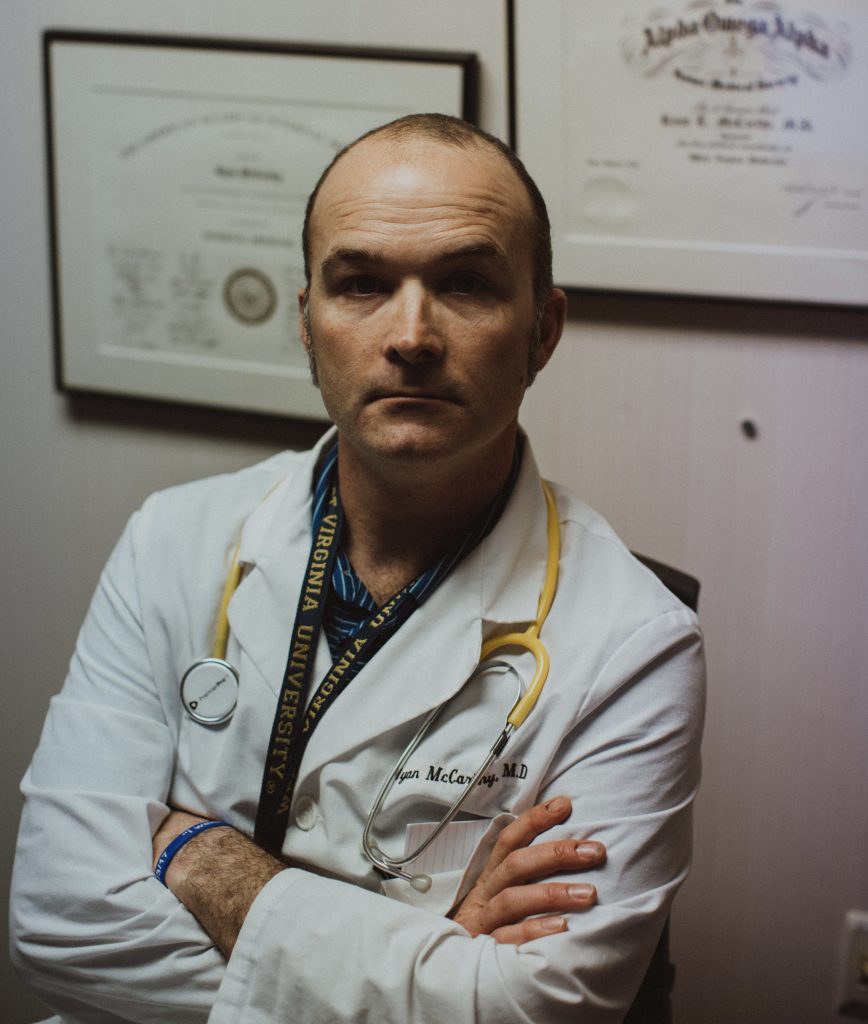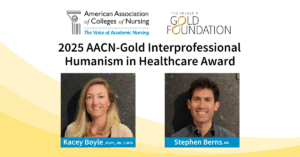Two decades after his White Coat Ceremony, a physician reflects on its meaning
2023 marks the 30th anniversary of the White Coat Ceremony, a program of the Gold Foundation, which Dr. Arnold P. Gold envisioned as a ritual to reinforce the importance of compassion in healthcare at a critical moment in training. It began at Columbia University’s Vagelos College of Physicians & Surgeon and has grown to hundreds of medical, nursing, and other health professions schools all over the world. We welcome your own reflections on your White Coat Ceremony. Send them to balcala@gold-foundation.org.
Medicine is demanding and unpredictable, so much so that, in preparing for the journey, we are given clothing — a coat, which is always white. Despite wearing one for decades, I have only recently grasped the meaning sewn into its liner. For so many years, I worked in my coat and did not give it my proper attention. Now, after a pandemic, I am evaluating my career and its symbols, thinking about what it all means.

Dr. Ryan McCarthy
Twenty-three years at the bedside taught me that, above all else, our mission in medicine is to heal. It is no coincidence that our coat, like a baptismal garment, American wedding dress, or Hajj ihram, is white. These are sacramental clothing, which we wear while attending births and deaths, and emotionally messy moments in between. We cannot ignore our spiritual origins or we betray our heritage, losing our north star along the way.
When I got my coat in 2000, I was a third-year medical student, almost bursting with enthusiasm as I passed this milestone. My parents attended the White Coat Ceremony at West Virginia University and beamed with pride. I understood this experience as best I could, though my understanding, like my medical skills, was limited at the time. No matter — the garment fit and I wore it. I was proud and hid my nervousness. In the photos from that time, I am all smiles.
Being charged with new responsibilities — altruism, adaptability, compassion — is an essential component of a White Coat Ceremony. I’m deeply grateful that West Virginia University made it a big deal. By doing so, my mentors baked a special quality inside me, even if it took 20 years to manifest.
This rite of passage is, at its heart, about uncertainty. The white coat is given to young future doctors (read: medical students) with the subtext: There is no way to predict what challenges are coming. It’s the profession saying, “We can’t give you everything, young colleagues, so take this — a shiny, new coat.” Skills and knowledge, they are invisible. But the coat says, “We have anointed you. Go forth and do good work.” The white coat made me visible.
This coat — this emblem — can be hard to grasp, both as physical cover and moral metaphor. Some days, I feel the coat has fused to my skin, making it impossible to separate where I stop and it starts. But I remember when this coat was new and foreign to me.
During my clinical rotations, the hospital was practically a walk-in refrigerator, and the coat gave me the gift of warmth. It had cavernous pockets for my reflex hammer and a drug reference book, making it a cargo vest for my medical safari. And what a wild adventure I had at Ruby Memorial Hospital. I saw a man bleed to death in front of me and tiny premature twins survive on ventilators. Had an actual zebra galloped down the hallway, I would not have been shocked. A helmet would have been helpful, but I was only given a coat.
Medicine is a messy affair, with blood, mucus, vomit, or worse in our workplace. In this sense, the white coat is an apron. I believe my name is on my jacket because I am not replaceable, but the coat is. Some days when I tossed my coat into the washing machine I cringed, seeing humanity’s mess splattered on me.
A white coat is the uniform of a scientist, a fact so painfully obvious to me that I did not question it. The COVID-19 pandemic proved that the rational part of our profession — the science —must be protected. Medicine is an art form with ever-increasing drugs, treatments, and procedures; there has never been more to learn.
In a world of internet cures, science is frequently doubted by patients who confront me in my office, hostile to data. In our white coats, we are the sales force for science, pitching the public our wares. At the same time, we posture like artists, standing in smocks before easels, pondering what portrait will arise from this human canvas.
On hard days, I worry my metaphorical white coat is threadbare, a natural consequence of giving all of my skills, and myself, away. In other ways, I know it is double-stitched and strong. Having survived a pandemic, I know it takes love, of people, medicine, and service. It takes understanding that nervousness will come with new responsibilities, and these difficult feelings never go away. I often wrap myself in my coat’s warmth as I take deep breaths, summoning the almighty to give me strength and courage. I’ve learned to live in unsettled harmony with these feelings; they keep me humble, aware that I should consider myself a novice. It is, after all, the practice of medicine.
The public expects us to minister to them, whether they say it or not. Many of us hear confessions which involve all flavors of humanity’s tragedy. The white coat conscripts as clergy, capable of absolving transgressions and supporting new paths and life choices.
This walk-on role was unsettling for me as a new doctor, but, all these years later, it’s my favorite. Listening to someone spill their darkest trauma, then lovingly providing them emotional support, often with a Kleenex and a hug — nothing pleases me more. The beauty of these moments never gets stale. Each one reconnects me to our core purpose.
These private moments, unscripted and often disjointed, these are the core of medicine. I’m convinced that every time I give someone a hug when wearing my white coat, a piece of it rubs off on them. It is a small dose of healing, human love squeezed out of me and into another.
I am — we are — called to this human connection when we are entrusted with a white coat.


